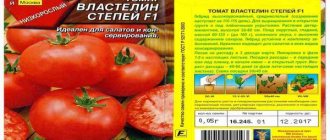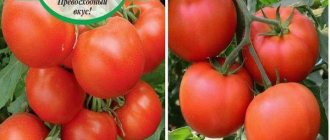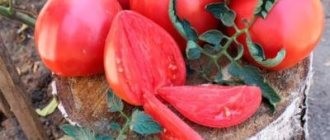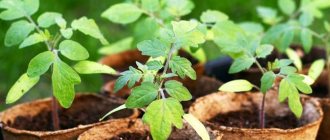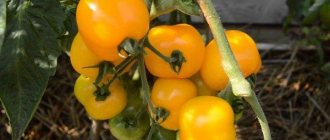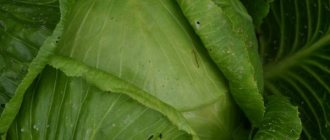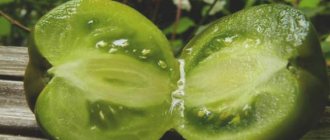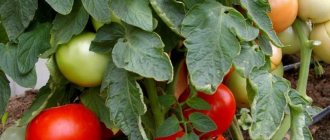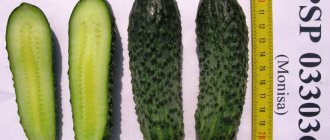| Ripening period: | 110-115 days |
| Shape, weight of fruits: | elongated, pepper-shaped; 120-150 g |
| Bush type: | indeterminate |
| Growing regions: | all Russia |
| Productivity: | 6 kg per bush |
The Chukhloma tomato has proven itself well among gardeners due to its high yield, excellent taste of fruits, and high commercial characteristics. It can be classified as the best yellow-fruited tomato. Resistance to nightshade diseases and unfavorable weather factors make the variety in demand in many regions of Russia. The cultivar achieves the best yield indicators when grown in protected soil.
Description and characteristics of the variety
The Chukhloma cultivar from the Gavrish agricultural company is a tall liana-like plant with dark green wrinkled foliage. In greenhouse conditions it reaches a height of more than 2 m.
Medium early ripening variety. It forms long clusters, each of which contains 10-15 bright orange cylindrical fruits with a spout at the end (see photo).
The first cluster grows above the ninth leaf, the next after three leaves. The length of each brush reaches 20-30 cm, which hang like garlands, almost completely covering the foliage. From the outside, the bush resembles a decorated Christmas tree.
Tomato fruits are dense, fleshy with a strong skin, 2-3 seed chambers. The pulp is bright orange, without white streaks, has an excellent taste and pronounced aroma. Tomatoes contain a high amount of carotene and do not cause allergies. Suitable for fresh consumption, dietary food, and for winter preparations.
The variety is hardy and produces a stable harvest in conditions of temperature changes and cold weather. Ripe fruits can hang on a branch for a long time without cracking. Tomatoes tolerate transportation well and are stored for a long time.
On a note! Picked at the technical ripeness stage, tomatoes ripen perfectly at home without loss of taste.
Farmer reviews
The Chukhloma tomato is cultivated in almost any climatic conditions, in open and closed ground. The variety has more advantages than disadvantages, which is why vegetable growers prefer it.
Elena, Perm: “Last year I grew the Chukhloma variety. The bushes are tall, up to 2.5 m. The plant has many cluster-like clusters - each with up to 10 tomatoes. The fruits are slightly dry; if they are overripe, voids appear inside. They taste sweet. The vegetables are oblong - I put them in the jar while standing, but they don’t crack. The peel is strong, but not rough. The tomatoes look great in a jar. I liked this type of culture. Next time I will plant more. I advise everyone!".
Olga, Kirov: “Before this, my mother always grew the Chukhloma tomato. That year I tried to plant it too. The variety is quite productive and does not require special attention. The bushes do not get sick and are not affected by pests. Plants formed into 1 stem. Tomatoes have an excellent taste, but I like them better when pickled, and they look wonderful. In addition, the culture does not cause allergies, which is important in our family.”
Vasily, Tyumen: “ In a gardening store, the seller advised me to buy Chukhloma tomato seeds. I immediately liked the photo on the packaging. I grew tomatoes in open ground. I didn't like this variety. One vegetable weighed about 80–100 g. The taste was average, neither sour nor sweet. I will look for new varieties for myself.”
Sowing dates and care features
Chukhloma seedlings grow easily, so sowing is carried out no earlier than March 15th. The variety can be affected by late blight; attention must be paid to the pre-planting preparation of seeds: disinfection, hardening, treatment with growth stimulants.
Seedlings are planted in a greenhouse in the first ten days of May, when the soil warms up to t +15˚C.
Properly grown seedlings should be stocky and have 6 true leaves. Hardened tomato seedlings have a purple lower part of the trunk and dark green tops.
The Chukhloma tomato has strong growth energy, this explains some of the nuances of the cultivar’s agricultural technology:
- Planting holes are prepared according to a 60x40 cm pattern; no more than 4 plants are grown per 1 sq.m.
- In greenhouse conditions, Chukhloma bushes are formed strictly into one stem, regularly removing stepsons. The density of the crop negatively affects the yield.
- The cultivar needs to be tied up several times a season; not only the stem is tied up, but also the heaviest clusters.
- Tomato should not be overfed. If there is an excess of nutrients, there will be an increase in green mass to the detriment of fruiting. Organic matter is added once at the beginning of the growing season. During flowering and fruiting, the bushes are fed with mineral potassium-phosphorus fertilizers.
- Chukhloma loves abundant watering, which is carried out once a week, in extreme heat - 2 times a week. During fruit ripening, the number of waterings is reduced; excess moisture can lead to watery tomatoes.
- After the formation of the 8th fruit cluster, the top of the tomato is pinched to allow the set tomatoes to ripen.
On a note! Chukhloma tomatoes require careful care. You can achieve abundant fruiting only by correctly forming the bushes, systematically removing stepchildren, and observing the schedule of watering and fertilizing.
Reviews from those who planted Chukhloma tomato
Rosinka_83, Kaluga region
I planted Chukhloma seeds from the Gavrish company. The bushes have grown to 2.5 m, there are not very many bunches, but they are like clusters - each has 8-10 tomatoes, slightly dry, and voids appear when ripening. The taste can be called sweet, especially when completely ripe. True, they are a little long - I put them in a jar while standing, but they don’t fall apart. The skin is strong, but not rough. They look very elegant in a jar. I planted 2 bushes in a greenhouse for testing, next year I’ll try it under a larger film.
Svetlana, Perm, working pensioner
I had the original seeds of the Chukhloma variety from Gavrish, as written on the package. Planted under film in high beds. I didn't like this variety at all! It sits for a long time, there are few fruits and the largest one is no more than 80 g, there is no taste at all... For me, it’s either sweeter or sour. The only thing I like is the shape and color - orange. I planted it for 2 years, still hoping that it would show itself. No, I won’t plant any more, I won’t occupy the land.
Grandmother Elena, Kursk
You have to believe what they write on the package, especially since the grade is GOST. If it is written that it is for film shelters and greenhouses, there is no point in planting it in open ground. There is no yield in the exhaust gas. And 4 bushes under the film were strewn from top to bottom with tomatoes; there were 22 brushes on one bush! It grew into 2 stems, in August I decided not to remove the new stepsons, all of them managed to bear fruit. They were collected on October 7 and matured in the basement until the new year. The verdict of my family is to plant more!
Disease resistance
The description of the variety states that Chukhloma is genetically resistant to fusarium, cladosporiosis, and mosaic virus. If agricultural practices are violated, blossom end rot may appear on some fruits.
The main task of the gardener is to protect plants from late blight in order to prolong fruiting until the onset of cold weather.
Basic measures to prevent late blight:
- soil disinfection in spring and autumn in a greenhouse with the Baikal preparation;
- spraying Chukhloma bushes in June with a 1% solution of Bordeaux mixture or another copper-containing preparation;
- regular ventilation of the greenhouse;
- mulching between rows;
- cutting off part of the leaves at the bottom of the plant.
Prophylactic spraying every 14 days with biological products “Fitosporin M” or “Alirin B” gives good results. The products are safe and can be used during fruiting.
Advantages and disadvantages
Positive qualities of the Chukhloma cultivar:
- high productivity;
- extended fruiting;
- delicious fruits rich in vitamins;
- versatility of crop use;
- high immunity to diseases;
- resistance to fluctuations in temperature and humidity in the greenhouse;
- suitability for long-term storage.
Flaws:
- the difficulty of forming a bush;
- the need for preventive measures against late blight;
- low juiciness, voids in the fruit pulp due to irregular watering.
Chukhloma tomatoes have a number of advantages; minor shortcomings can be easily corrected with proper care of the plant.
Tomato diseases
It is believed that the Chukhloma variety is resistant to many nightshade diseases. But to protect tomatoes from late blight, it is better to use preventive measures.
This fungal disease usually appears from the middle of the season, when heavy rains begin. The disease spreads in high humidity and low temperatures. The entire plant and even the fruits are affected. The disease appears in the form of grayish-brown spots.
As a preventive measure it is recommended:
- Avoid planting Chukhloma tomatoes next to potatoes or after potatoes and peppers;
- Regularly pruning the plant and weeding the ground;
- if the Chukhloma tomato is grown in a greenhouse, it is necessary to ventilate it frequently and prevent condensation from forming on the walls;
- the remains of the tops are burned, and the greenhouse is treated with bleach.
The Chukhloma tomato responds gratefully to timely feeding and constant care. Therefore, with due attention, even a novice gardener will reap a decent harvest.
Similar varieties
According to the characteristics and description of the variety, the Chukhloma tomato is similar to the following cultivars:
- Amber Cup;
- Southern tan;
- Banana orange;
- Gold fish;
- Russian bells;
- Khokhloma.
Amber cup is a mid-season indeterminate variety, 1.5-1.8 m high. Can be grown in any conditions. Plum-shaped tomatoes of orange-yellow color weighing 100-130 g are collected in brushes of 5-8 pieces. The fruits are sweet, aromatic, the flesh is juicy and tender. The plant needs staking and bush formation. Productivity up to 10 kg per sq.m.
Southern tan is a mid-season cultivar for growing in protected soil. The plant, up to 1.7 m high, forms 6-7 clusters with 3-4 red-orange tomatoes weighing 150-300 g. The fruits are fleshy, pepper-shaped, and do not crack on the bush. The tomato is resistant to most fungal diseases and is affected by blossom end rot. Harvest from one bush up to 5 kg.
Orange banana is a mid-early ripening variety recommended for cultivation in greenhouses. The bush is sparsely leafy, with a strong stem, 1.5 m high. Orange cylindrical tomatoes weigh 100-140 g. Up to 8 pieces are tied in each brush. The fruits are juicy, sweet, with a honey aroma and thin skin. The cultivar is resistant to late blight and other nightshade diseases. Productivity 8-9 kg per sq.m.
Goldfish is a mid-late tomato for growing in greenhouse conditions with a bush height of up to 2 m. Without pinching, it grows strongly and branches. Oblong orange-colored tomatoes, weighing 80-120 g, are often affected by blossom end rot when exposed to changes in humidity. The variety has average resistance to diseases and requires prevention. Productivity up to 10 kg per square meter. m.
Russian bells
Russian bells are an early ripening cultivar, with many characteristics similar to Chukhloma. Tomatoes reach technical ripeness 98-102 days after emergence. In comparison with Chukhloma, this variety is lower. Fruits weighing 90 g, elongated, orange in color. Russian bells have a record beta-carotene content.
Tomato Khokhloma is an identical variety to Chukhloma. The only difference between these varieties of tomatoes is the color of the skin, which is red.
Growing rules
Plants can be planted both in a greenhouse and in open ground. In any case, it is advisable to use seedlings.
Sowing seeds
To ensure a high yield of Chukhloma tomatoes, it is necessary to adhere to the technology of germinating seedlings. It is better to sow tomato seeds between the 10th and 15th of March.
To ensure rapid growth of Chukhloma seeds, it is advisable to prepare fertile soil: mix turf, humus soil and peat in equal parts. For seed germination, you can use shallow boxes - 5-7 cm high. The soil is moistened before planting.
Make grooves in the soil about 1 cm deep, at a distance of 3-4 cm from each other. Seeds are planted in increments of 1.5-2 cm.
Advice! You should not plant more often, otherwise it will be more difficult to divide the seedlings for picking.
The grooves are covered with soil.
Containers with seedlings are placed in a warm place (temperature approximately +25-30˚ C). To prevent the soil from drying out, cover the boxes with polyethylene or glass. You need to monitor soil moisture daily. When the soil dries out, irrigate it abundantly. If mold suddenly appears on the ground, it is carefully removed and the surface is watered with a solution of potassium permanganate.
As soon as the Chukhloma tomato seeds germinate (in about 5-6 days), the containers with seedlings are placed in the most illuminated place. It is believed that in the first 2-3 days after germination, the sprouts need to be provided with round-the-clock lighting.
After two leaves appear (as in the photo), the tomato seedlings of the Chukhloma variety are plucked and planted in separate pots. For about a month, the seedlings grow at one constant temperature of + 23-24˚ C. And then they begin to harden the seedlings - lower the temperature by one or two degrees.
Two weeks before planting seedlings in open ground, they begin to take them out into the open air for a short time. Every day the hardening time increases little by little.
Advice! It is not recommended to keep seedlings in the cold for a long time, as this can lead to slower plant growth.
Before planting an indeterminate tomato variety, trellises are installed in advance to tie up the seedlings. The stakes/sticks are installed 2-2.5 m high. Gardeners come up with trellis options themselves: plastic mesh, individual stakes, rows of wire.
Important! It is not recommended to plant tomatoes after peppers, eggplants or next to potatoes. It is necessary to prevent possible infection of tomatoes with fungal diseases.
Tomatoes of the Chukhloma variety are planted in the ground in increments of 45-55 cm, leaving 70-80 cm between rows. It is recommended to create a furrow for the seedlings. In this way, the plants will be better hydrated, and later, during hilling, the grown Chukhloma tomatoes will grow on the ridge. This will prevent the stems from getting wet when watering and will be an excellent preventive measure against disease.
Watering rules
Like any tomatoes, the Chukhloma variety is watered at the root. If you prepare the furrows in advance, there will be no problems with soil moisture.
Important! The Chukhloma variety is indeterminate, so watering is of great importance. Lack of moisture can reduce yields and lead to fruit shredding.
To eliminate changes in soil moisture, mulching is used. This is especially important when fixing tomatoes on trellises, when the soil is not shaded and dries quickly. And just mulching eliminates this problem.
Regulate the frequency of watering of the Chukhloma tomato variety, taking into account the planting region and the growth phase of the plant. Adult tomatoes require more water, and the air temperature rises by the middle of the season. It should also not be overlooked that the indeterminate variety Chukhloma constantly blooms and bears fruit.
